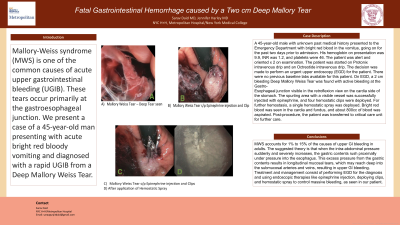Back

Poster Session A - Sunday Afternoon
Category: GI Bleeding
A0321 - Fatal Gastrointestinal Hemorrhage Caused by a Two cm Deep Mallory Weiss Tear
Sunday, October 23, 2022
5:00 PM – 7:00 PM ET
Location: Crown Ballroom

- SD
Sarav Daid, MD
New York Medical College/ Metropolitan Medical Center
New York, NY
Presenting Author(s)
Sarav Daid, MD1, Jennifer Harley, MD2
1Metropolitan Hospital, New York, NY; 2New York Medical College/ NYCHH – Metropolitan Hospital Center, Manhattan, NY
Introduction: Mallory-Weiss syndrome (MWS) is one of the common causes of acute upper gastrointestinal bleeding (UGIB). These tears occur primarily at the gastroesophageal junction. We present a case of a 45-year-old man presenting with acute bright red bloody vomiting and diagnosed with a rapid UGIB from a Deep Mallory Weiss Tear.
Case Description/Methods: A 45-year-old male with unknown past medical history presented to the Emergency Department with bright red blood in the vomitus, going on for the past two days prior to admission. His hemoglobin on presentation was 9.9, INR was 1.2, and platelets were 46. The patient was alert and oriented x 2 on examination. The patient was started on Protonix intravenous drip and an Octreotide intravenous drip. The decision was made to perform an urgent upper endoscopy (EGD) for the patient. There were no previous baseline labs available for this patient. On EGD, a 2 cm bleeding Deep Mallory Weiss Tear was found with active bleeding at the Gastro-
Esophageal junction visible in the retroflexion view on the cardia side of the stomach. The spurting area with a visible vessel was successfully injected with epinephrine, and four hemostatic clips were deployed. For further hemostasis, a single hemostatic spray was deployed. Bright red blood was seen in the cardia and fundus, and about 800cc of blood was aspirated. Post-procedure, the patient was transferred to critical care unit for further care.
Discussion: MWS accounts for 1% to 15% of the causes of upper GI bleeding in adults. The suggested theory is that when the intra-abdominal pressure suddenly and severely increases, the gastric contents rush proximally under pressure into the esophagus. This excess pressure from the gastric contents results in longitudinal mucosal tears, which may reach deep into the submucosal arteries and veins, resulting in upper GI bleeding. Treatment and management consist of performing EGD for the diagnosis and using endoscopic therapies like epinephrine injection, deploying clips, and hemostatic spray to control massive bleeding, as seen in our patient.

Disclosures:
Sarav Daid, MD1, Jennifer Harley, MD2. A0321 - Fatal Gastrointestinal Hemorrhage Caused by a Two cm Deep Mallory Weiss Tear, ACG 2022 Annual Scientific Meeting Abstracts. Charlotte, NC: American College of Gastroenterology.
1Metropolitan Hospital, New York, NY; 2New York Medical College/ NYCHH – Metropolitan Hospital Center, Manhattan, NY
Introduction: Mallory-Weiss syndrome (MWS) is one of the common causes of acute upper gastrointestinal bleeding (UGIB). These tears occur primarily at the gastroesophageal junction. We present a case of a 45-year-old man presenting with acute bright red bloody vomiting and diagnosed with a rapid UGIB from a Deep Mallory Weiss Tear.
Case Description/Methods: A 45-year-old male with unknown past medical history presented to the Emergency Department with bright red blood in the vomitus, going on for the past two days prior to admission. His hemoglobin on presentation was 9.9, INR was 1.2, and platelets were 46. The patient was alert and oriented x 2 on examination. The patient was started on Protonix intravenous drip and an Octreotide intravenous drip. The decision was made to perform an urgent upper endoscopy (EGD) for the patient. There were no previous baseline labs available for this patient. On EGD, a 2 cm bleeding Deep Mallory Weiss Tear was found with active bleeding at the Gastro-
Esophageal junction visible in the retroflexion view on the cardia side of the stomach. The spurting area with a visible vessel was successfully injected with epinephrine, and four hemostatic clips were deployed. For further hemostasis, a single hemostatic spray was deployed. Bright red blood was seen in the cardia and fundus, and about 800cc of blood was aspirated. Post-procedure, the patient was transferred to critical care unit for further care.
Discussion: MWS accounts for 1% to 15% of the causes of upper GI bleeding in adults. The suggested theory is that when the intra-abdominal pressure suddenly and severely increases, the gastric contents rush proximally under pressure into the esophagus. This excess pressure from the gastric contents results in longitudinal mucosal tears, which may reach deep into the submucosal arteries and veins, resulting in upper GI bleeding. Treatment and management consist of performing EGD for the diagnosis and using endoscopic therapies like epinephrine injection, deploying clips, and hemostatic spray to control massive bleeding, as seen in our patient.

Figure: Therapeutics done for Deep Mallory Weiss Tear
Disclosures:
Sarav Daid indicated no relevant financial relationships.
Jennifer Harley indicated no relevant financial relationships.
Sarav Daid, MD1, Jennifer Harley, MD2. A0321 - Fatal Gastrointestinal Hemorrhage Caused by a Two cm Deep Mallory Weiss Tear, ACG 2022 Annual Scientific Meeting Abstracts. Charlotte, NC: American College of Gastroenterology.
